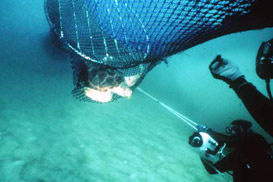Bycatch
Often, fishermen and women, fishers catch more than what they intended to. Although they wish to catch fish or shellfish, marine mammals, sea turtles, and seabirds get caught in their nets or lines. To these air breathers, getting caught in a fishing line or net is almost certain death because they will drown. Other victims of bycatch are young fish that are too small to be sold at market and other species of fish and invertebrates outside the intended catch.
Bycatch is a major problem that results in a lot of unnecessary waste. For example, a fisher may be trying to catch shrimp, but may catch sea turtles, small fish, and other invertebrates, all of which will be discarded. A recent study found that for every 5 pounds of seafood caught in United States waters, at least 1 pound will be discarded. This statistic is even worse in the shrimp fishery; for every 1 pound of shrimp caught, 3-10 pounds of other animals are discarded. These statistics are even more wasteful in some other countries.
Solutions to Bycatch
As alternative methods to the traditional pole-fishing have been created, the negative impacted of excessive bycatch as been the result. Finding the happy middle ground where unnecessary waste is eliminated and the desired fish more directly targeted has not been an easy task. There are some solutions to this devastating problem; the most important of all is awareness and education of the general public.
Consumer power:
People who buy seafood have a tremendous amount of power! We need to train ourselves to buy from fishers that practice environmentally friendly fishing practices. There are several sites that offer a free 'wallet card.' Keep these cards in your wallet so that when you and your family are shopping or dining out, you know which types of fish are being caught sustainably (in a manner that would allow the population to keep going).
For more information see:
http://www.blueocean.org/pdfs/miniguide_color.pdf
(this site allows you to print a 'wallet card' which you can carry with you and share with your friends and family)
http://www.mbayaq.org/cr/SeafoodWatch/web/sfw_regional.aspx?region_id=6
(this site allows you to select your region of the country and download a guide specifically for where you live. For example you can determine which type of tuna in your area are dolphin safe)
Technology
Advances in technology have made it possible for fishers to use methods that help them decrease bycatch and even make them more money! Sometimes, laws require fishers to use this technology or face severe fines. Some of these technologies are:

- Turtle Excluder Devices (TEDs): Turtles have been a hard hit species because they tend to migrate through the paths of the fishers and get caught in their nets and lines. The turtles then drown because they are unable to return to the surface to take a breath. TEDs are a series of bars located inside the net which allow for smaller fish to pass through and remain inside. Should a larger animal such as sea turtle get trapped in the net, they are then guided out of the net through a flap. This device has prevented the drowning of countless sea turtles as well as reduce the number of larger fish bycatch.
- Tori Lines: Sea turtles are not the only species harmed from fishing practices. Sea birds are also in danger of becoming entangled in long fishing lines called "longlines." In longline fisheries, a boat will have bait lines that are dragged behind it. These lines can sometimes be as long as 130 km (81 miles). These lines can carry thousands of hooks baited for larger fish such as tuna and sea bass. Sea birds such as the albatross that fly overhead dive down to scoop up the bait on the hooks and in the process get tangled in the long fishing lines. The fishers may not even be aware this is happening because the lines stretch so far from the boat. Tori Lines are longlines that have colored, flapping streamers attached to them in order to scare the birds and prevent them from diving down toward the lines.
- Circle Hooks on longlines: Sea birds are not the only bycatch on longlines. Often times other animals, such as sea turtles, get caught in the hooks that are attached to the longlines. The original hook used called the J-hook would easily snag a passing animal. The newly designed circle-hook cannot as easily catch an animal swimming by. It is reported that using the circle-hooks has decreased the loggerhead sea turtle from being hooked by 65% and the leatherbacks by nearly 90%.
- Avoiding purse seine, trawling, etc., and using a more sustainable method of fishing: There are some fishing practices that simply cannot avoid excessive bycatch. Two examples of this are purse seine fishing and trawling. Purse seine fishing is when a boat loops a large net in a circle around a school of fish and then pulls the net in toward the boat. This method not only traps the schooling fish but any other animals in the area.
Trawling is another method where a large net is dragged behind the boat at various depths (depending on the type of fish desired) and traps any animal in its path.
In both cases, the bycatch is immense. Often times sea turtles, whales, dolphins and sharks get caught and are killed in the nets. These fishing methods should be avoided in order to protect the ocean's animal population.